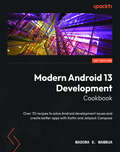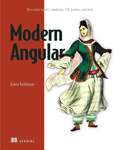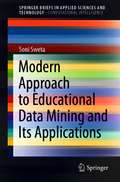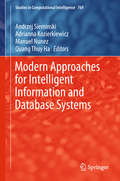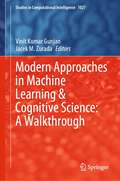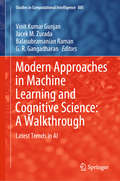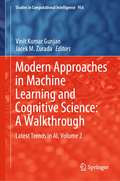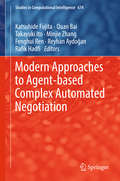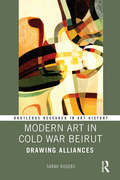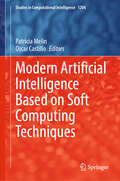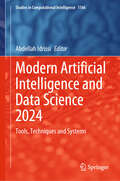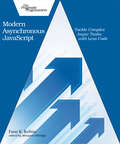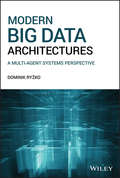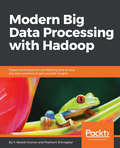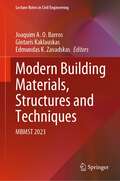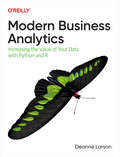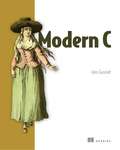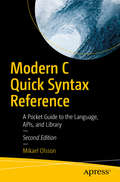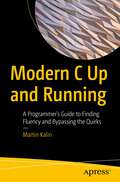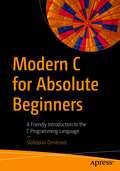- Table View
- List View
Modern Android 13 Development Cookbook: Over 70 recipes to solve Android development issues and create better apps with Kotlin and Jetpack Compose
by Madona S. WambuaSave months of trial and error with concise guided recipes in this part-color guide and build exceptional Android applications and wearables and support the new foldable technology by using the latest Jetpack libraries Key FeaturesLeverage the power of the latest Jetpack libraries in your day-to-day Android development tasksExplore Wear OS and build large screens to support the foldable world using the declarative approachWrite tests and debug your code as you discover the most useful tips, tricks, and best practicesPurchase of the print or Kindle book includes a free PDF eBookBook DescriptionAndroid is a powerful operating system widely used in various devices, phones, TVs, wearables, automobiles, and more. This Android cookbook will teach you how to leverage the latest Android development technologies for creating incredible applications while making effective use of popular Jetpack libraries. You’ll also learn which critical principles to consider when developing Android apps. The book begins with recipes to get you started with the declarative UI framework, Jetpack Compose, and help you with handling UI states, Navigation, Hilt, Room, Wear OS, and more as you learn what's new in modern Android development. Subsequent chapters will focus on developing apps for large screens, leveraging Jetpack’s WorkManager, managing graphic user interface alerts, and tips and tricks within Android studio. Throughout the book, you'll also see testing being implemented for enhancing Android development, and gain insights into harnessing the integrated development environment of Android studio. Finally, you’ll discover best practices for robust modern app development. By the end of this book, you’ll be able to build an Android application using the Kotlin programming language and the newest modern Android development technologies, resulting in highly efficient applications.What you will learnUse Kotlin programming to build your Android applicationsLeverage modern Android development (MAD) libraries to create exceptional appsExplore modern app architecture concepts such as model-view-viewmodel (MVVM)Utilize dependency injection, clean architecture, and module organizationDiscover how to write UI and unit tests for your applicationsGet to grips with paging, data binding, and datastoreBuild large screens to support the new foldable worldExplore principles of Wear OS in modern Android developmentWho this book is forThis book is for active junior-to-mid-level Android developers with one to two years of professional experience in developing Android applications who are interested in advancing their knowledge of Android development. The recipes in this book use Kotlin and not Java.
Modern Angular: Also covers signals, standalone, SSR, zoneless, and more
by Armen VardanyanDiscover the new features and techniques of the most modern versions of Angular.The powerful Angular framework is ever-evolving, with each new iteration bringing amazing new modern features. Modern Angular gets you rapidly up to speed with Angular&’s latest innovations. Inside Modern Angular you&’ll learn how to: • Create modern Angular apps with the newest framework capabilities • Setting up and structuring your Angular projects • Implement advanced testing strategies for Angular • Benefit from new improvements in debugging, image loading, and component inputs • Apply state management with reactive programming • Explore signals and server-side rendering • Migrate legacy Angular projects to modern practices • Refactor old Angular patterns using new techniques • Use modern performance optimization approaches to improve User Experience Discover new ways of working with components, dependency injection, RxJS, Signals, and more—all through building a complete enterprise-grade HR management system! You&’ll soon be improving your daily development with Angular&’s quality-of-life features, upgrading your app&’s performance with server-side rendering, and getting ready for what&’s coming Angular&’s future. Plus, detailed migration guides demonstrate ways to update existing apps to modern patterns, and make it easy to modernize your legacy code. Purchase of the print book includes a free eBook in PDF and ePub formats from Manning Publications. About the technology Modern web applications have to handle serious challenges, such as complex state management, reactive programming, and SEO. With a host of new features, ecosystem tools, and programming practices, the Angular web framework tackles modern web development head on. If you haven&’t tried modern Angular, you&’re in for a treat! About the book Modern Angular updates your web development skills to take advantage of new Angular features like signals, server-side rendering, and zoneless change detection. Each chapter explores an exciting capability by adding it hands-on to a full-featured app for managing HR systems. Along the way, you&’ll explore dependency injection, RxJS, and standalone components, and pick up techniques for upgrading legacy apps. What's inside • Advanced testing strategies • RxJS and custom operators • Performance and search engine optimization • Migrate legacy Angular projects About the reader For experienced Angular developers. Covers Angular versions 12 and later. About the author Armen Vardanyan is a developer, educator, and Google Developer Expert for Angular. He writes articles about Angular, TypeScript, NgRx, and is a panelist for the popular Adventures in Angular podcast. Table of Contents 1 Welcome to modern Angular 2 A standalone future 3 Revitalized dependency injection 4 New capabilities of Angular building blocks 5 RxJS in modern Angular 6 Signals: A new approach to reactive programming 7 Signals: A deep dive 8 Unit testing in modern Angular 9 Modern Angular everywhere 10 What&’s next in modern Angular?
Modern Approach to Educational Data Mining and Its Applications (SpringerBriefs in Applied Sciences and Technology)
by Soni SwetaThis book emphasizes that learning efficiency of the learners can be increased by providing personalized course materials and guiding them to attune with suitable learning paths based on their characteristics such as learning style, knowledge level, emotion, motivation, self-efficacy and many more learning ability factors in e-learning system. Learning is a continuous process since human evolution. In fact, it is related to life and innovations. The basic objective of learning to grow, aspire and develop ease of life remains the same despite changes in the learning methodologies. Introduction of computers empowered us to attain new zenith in knowledge domain, developed pragmatic approach to solve life’s problem and helped us to decipher different hidden patterns of data to get new ideas. Of late, computers are predominantly used in education. Its process has been changed from offline to online in view of enhancing the ease of learning. With the advent of information technology, e-learning has taken centre stage in educational domain. In e-learning context, developing adaptive e-learning system is buzzword among contemporary research scholars in the area of Educational Data Mining (EDM). Enabling personalized systems is meant for improvement in learning experience for learners as per their choices made or auto-detected needs. It helps in enhancing their performance in terms of knowledge, skills, aptitudes and preferences. It also enables speeding up the learning process qualitatively and quantitatively. These objectives are met only by the Personalized Adaptive E-learning Systems in this regard. Many noble frameworks were conceptualized, designed and developed to infer learning style preferences, and accordingly, learning materials were delivered adaptively to the learners. Designing frameworks help to measure learners’ preferences minutely and provide adaptive learning materials to them in a way most appropriately.
Modern Approaches for Intelligent Information and Database Systems (Studies In Computational Intelligence #769)
by Andrzej Sieminski Adrianna Kozierkiewicz Manuel Nunez Quang Thuy HaThis book offers a unique blend of reports on both theoretical models and their applications in the area of Intelligent Information and Database Systems. The reports cover a broad range of research topics, including advanced learning techniques, knowledge engineering, Natural Language Processing (NLP), decision support systems, Internet of things (IoT), computer vision, and tools and techniques for Intelligent Information Systems. They are extended versions of papers presented at the ACIIDS 2018 conference (10th Asian Conference on Intelligent Information and Database Systems), which was held in Dong Hoi City, Vietnam on 19–21 March 2018. What all researchers and students of computer science need is a state-of-the-art report on the latest trends in their respective areas of interest. Over the years, researchers have proposed increasingly complex theoretical models, which provide the theoretical basis for numerous applications. The applications, in turn, have a profound influence on virtually every aspect of human activities, while also allowing us to validate the underlying theoretical concepts.
Modern Approaches in IoT and Machine Learning for Cyber Security: Latest Trends in AI (Internet of Things)
by Vinit Kumar Gunjan Mohammed Usman Mohd Dilshad Ansari ThiDieuLinh NguyenThis book examines the cyber risks associated with Internet of Things (IoT) and highlights the cyber security capabilities that IoT platforms must have in order to address those cyber risks effectively. The chapters fuse together deep cyber security expertise with artificial intelligence (AI), machine learning, and advanced analytics tools, which allows readers to evaluate, emulate, outpace, and eliminate threats in real time. The book’s chapters are written by experts of IoT and machine learning to help examine the computer-based crimes of the next decade. They highlight on automated processes for analyzing cyber frauds in the current systems and predict what is on the horizon. This book is applicable for researchers and professionals in cyber security, AI, and IoT.
Modern Approaches in Machine Learning & Cognitive Science: A Walkthrough (Studies in Computational Intelligence #1027)
by Vinit Kumar Gunjan Jacek M. ZuradaThis book provides a systematic and comprehensive overview of AI and machine learning which have got the ability to identify patterns in large and complex data sets. A remarkable success has been experienced in the last decade by emulating the brain computer interface. It presents the cognitive science methods and technologies that have played an important role at the core of practical solutions for a wide scope of tasks between handheld apps, industrial process control, autonomous vehicles, environmental policies, life sciences, playing computer games, computational theory, and engineering development. The chapters in this book focuses on audiences interested in machine learning, cognitive and neuro-inspired computational systems, their theories, mechanisms, and architecture, which underline human and animal behaviour, and their application to conscious and intelligent systems. In the current version, it focuses on the successful implementation and step-by-step explanation of practical applications of the domain. It also offers a wide range of inspiring and interesting cutting-edge contributions on applications of machine learning and cognitive science such as healthcare products, medical electronics, and gaming.
Modern Approaches in Machine Learning and Cognitive Science: Latest Trends in AI (Studies in Computational Intelligence #885)
by G. R. Gangadharan Vinit Kumar Gunjan Jacek M. Zurada Balasubramanian RamanThis book discusses various machine learning & cognitive science approaches, presenting high-throughput research by experts in this area. Bringing together machine learning, cognitive science and other aspects of artificial intelligence to help provide a roadmap for future research on intelligent systems, the book is a valuable reference resource for students, researchers and industry practitioners wanting to keep abreast of recent developments in this dynamic, exciting and profitable research field. It is intended for postgraduate students, researchers, scholars and developers who are interested in machine learning and cognitive research, and is also suitable for senior undergraduate courses in related topics. Further, it is useful for practitioners dealing with advanced data processing, applied mathematicians, developers of software for agent-oriented systems and developers of embedded and real-time systems.
Modern Approaches in Machine Learning and Cognitive Science: Latest Trends in AI, Volume 2 (Studies in Computational Intelligence #956)
by Vinit Kumar Gunjan Jacek M. ZuradaThis book provides a systematic and comprehensive overview of machine learning with cognitive science methods and technologies which have played an important role at the core of practical solutions for a wide scope of tasks between handheld apps, industrial process control, autonomous vehicles, environmental policies, life sciences, playing computer games, computational theory, and engineering development. The chapters in this book focus on readers interested in machine learning, cognitive and neuro-inspired computational systems – theories, mechanisms, and architecture, which underline human and animal behaviour, and their application to conscious and intelligent systems. In the current version, it focuses on the successful implementation and step-by-step explanation of practical applications of the domain. It also offers a wide range of inspiring and interesting cutting-edge contributions to applications of machine learning and cognitive science such as healthcare products, medical electronics, and gaming. Overall, this book provides valuable information on effective, cutting-edge techniques and approaches for students, researchers, practitioners, and academicians working in the field of AI, neural network, machine learning, and cognitive science. Furthermore, the purpose of this book is to address the interests of a broad spectrum of practitioners, students, and researchers, who are interested in applying machine learning and cognitive science methods in their respective domains.
Modern Approaches in Machine Learning and Cognitive Science: Volume 4 (Studies in Computational Intelligence #1117)
by Vinit Kumar Gunjan Jacek M. Zurada Ninni SinghThis book provides a systematic and comprehensive overview of cognitive intelligence and AI-enabled IoT ecosystem and machine learning, capable of recognizing the object pattern in complex and large data sets. A remarkable success has been experienced in the last decade by emulating the brain–computer interface. It presents the applied cognitive science methods and AI-enabled technologies that have played a vital role at the core of practical solutions for a wide scope of tasks between handheld apps and industrial process control, autonomous vehicles, IoT, intelligent learning environment, game theory, human computer interaction, environmental policies, life sciences, playing computer games, computational theory, and engineering development.The book contains contents highlighting artificial neural networks that are analogous to the networks of neurons that comprise the brain and have given computers the ability to distinguish an image of a cat from one of a coconut, to spot pedestrians with enough accuracy to direct a self-driving car, and to recognize and respond to the spoken word. The chapters in this book focus on audiences interested in artificial intelligence, machine learning, fuzzy, cognitive and neurofuzzy-inspired computational systems, their theories, mechanisms, and architecture, which underline human and animal behavior, and their application to conscious and intelligent systems. In the current version, it focuses on the successful implementation and step-by-step execution and explanation of practical applications of the domain. It also offers a wide range of inspiring and interesting cutting-edge contributions on applications of machine learning, artificial intelligence, and cognitive science such as healthcare products, AI-enabled IoT, gaming, medical, and engineering.Overall, this book provides valuable information on effective, cutting-edge techniques, and approaches for students, researchers, practitioners, and academics in the field of machine learning and cognitive science. Furthermore, the purpose of this book is to address the interests of a broad spectrum of practitioners, students, and researchers, who are interested in applying machine learning and cognitive science methods in their respective domains.
Modern Approaches to Agent-based Complex Automated Negotiation
by Quan Bai Fenghui Ren Minjie Zhang Takayuki Ito Katsuhide Fujita Reyhan Aydoğan Rafik HadfiThis book addresses several important aspects of complex automated negotiations and introduces a number of modern approaches for facilitating agents to conduct complex negotiations. It demonstrates that autonomous negotiation is one of the most important areas in the field of autonomous agents and multi-agent systems. Further, it presents complex automated negotiation scenarios that involve negotiation encounters that may have, for instance, a large number of agents, a large number of issues with strong interdependencies and/or real-time constraints.
Modern Arm Assembly Language Programming: Covers Armv8-A 32-bit, 64-bit, and SIMD
by Daniel KusswurmGain the fundamentals of Armv8-A 32-bit and 64-bit assembly language programming. This book emphasizes Armv8-A assembly language topics that are relevant to modern software development. It is designed to help you quickly understand Armv8-A assembly language programming and the computational resources of Arm’s SIMD platform. It also contains an abundance of source code that is structured to accelerate learning and comprehension of essential Armv8-A assembly language constructs and SIMD programming concepts. After reading this book, you will be able to code performance-optimized functions and algorithms using Armv8- A 32-bit and 64-bit assembly language. Modern Arm Assembly Language Programming accentuates the coding of Armv8-A 32-bit and 64-bit assembly language functions that are callable from C++. Multiple chapters are also devoted to Armv8-A SIMD assembly language programming. These chapters discuss how to code functions that are used in computationally intense applications such as machine learning, image processing, audio and video encoding, and computer graphics. The source code examples were developed using the GNU toolchain (g++, gas, and make) and tested on a Raspberry Pi 4 Model B running Raspbian (32-bit) and Ubuntu Server (64-bit). It is important to note that this is a book about Armv8-A assembly language programming and not the Raspberry Pi. What You Will Learn See essential details about the Armv8-A 32-bit and 64-bit architectures including data types, general purpose registers, floating-point and SIMD registers, and addressing modes Use the Armv8-A 32-bit and 64-bit instruction sets to create performance-enhancing functions that are callable from C++ Employ Armv8-A assembly language to efficiently manipulate common data types and programming constructs including integers, arrays, matrices, and user-defined structures Create assembly language functions that perform scalar floating-point arithmetic using the Armv8-A 32-bit and 64-bit instruction sets Harness the Armv8-A SIMD instruction sets to significantly accelerate the performance of computationally intense algorithms in applications such as machine learning, image processing, computer graphics, mathematics, and statistics. Apply leading-edge coding strategies and techniques to optimally exploit the Armv8-A 32-bit and 64-bit instruction sets for maximum possible performance Who This Book Is For Software developers who are creating programs for Armv8-A platforms and want to learn how to code performance-enhancing algorithms and functions using the Armv8-A 32-bit and 64-bit instruction sets. Readers should have previous high-level language programming experience and a basic understanding of C++.
Modern Art in Cold War Beirut: Drawing Alliances (Routledge Research in Art History)
by Sarah RogersModern Art in Cold War Beirut: Drawing Alliances examines the entangled histories of modern art and international politics during the decades of the 1950s and 1960s. Positing the Cold War as a globalized conflict, fraught with different political ideologies and intercultural exchanges, this study asks how these historical circumstances shaped local debates in Beirut over artistic pedagogy, the social role of the artist, the aesthetics of form, and, ultimately, the development of a national art. Drawing on a range of archival material and taking an interdisciplinary approach, Sarah Rogers argues that the genealogies of modern art can never be understood as isolated, national histories, but rather that they participate in an ever contingent global modernism. This book will be of particular interest to scholars in art history, Cold War studies, and Middle East studies.
Modern Artificial Intelligence Based on Soft Computing Techniques (Studies in Computational Intelligence #1204)
by Oscar Castillo Patricia MelinThis book describes what we can call modern artificial intelligence that includes the theoretical developments and applications of soft computing techniques. Soft computing includes fuzzy logic, neural networks and meta-heuristic algorithms, as well as their hybrid combinations. There are papers with the main topics from type-1 to type-3 fuzzy logic, which basically consists of a group of papers that propose new concepts and algorithms based on type-1, type-2 and type-3 fuzzy logic and their applications. There are also papers that present theory and practice of meta-heuristics in diverse application areas. There are interesting papers on different applications of fuzzy logic, neural networks and hybrid intelligent systems in medical problems. In addition, we can find papers describing applications of fuzzy logic, neural networks and meta-heuristics in robotics problems.
Modern Artificial Intelligence and Data Science 2024: Tools, Techniques and Systems (Studies in Computational Intelligence #1166)
by Abdellah IdrissiThis book, through its various chapters presenting recent advances in Modern Artificial Intelligence and Data Science as well as their applications, aims to set up lasting and real applications necessary for both academics and professionals. By its proposals of new ideas, it serves as a real guide both to informed readers and to beginners in these specialized fields. It also covers applications that discuss how they can support societal challenges such as education, health, agriculture, clean energy, business, environment, and security. Readers will find here the fruit of many research ideas covering a wide range of application areas that can be explored for the advancement of their research or the development of their business. These ideas present new techniques and trends projected in various areas of daily life. This book is therefore intended for Designers, Developers, Decision-Makers, Consultants, Engineers, and of course Master's/Doctorate Students, Researchers, and Universities.
Modern Artificial Intelligence and Data Science: Tools, Techniques and Systems (Studies in Computational Intelligence #1102)
by Abdellah IdrissiThis Book, through its various chapters presenting the Recent Advances in Modern Artificial Intelligence and Data Science as well as their Applications, aims to set up lasting and real applications necessary for both academics and professionals. Readers find here the fruit of many research ideas covering a wide range of application areas that can be explored for the advancement of their research or the development of their business. These ideas present new techniques and trends projected in various areas of daily life. Through its proposals of new ideas, this Book serves as a real guide both for experienced readers and for beginners in these specialized fields. It also covers several applications that explain how they can support some societal challenges such as education, health, agriculture, clean energy, business, environment, security and many more. This Book is therefore intended for Designers, Developers, Decision-Makers, Consultants, Engineers, and of course Master's/Doctoral Students, Researchers and Academics.
Modern Asynchronous JavaScript
by Faraz K. KelhiniJavaScript today must interact with data-intensive APIs and networks. The solution is a program that can work asynchronously instead of finishing tasks in order. In modern JavaScript, instead of callbacks you'll use promises to improve your application's performance and responsiveness. JavaScript features introduced in ES2020, ES2021, and ESNext like Promise.allSettled(), Promise.any(), and top-level await help you develop small, fast, low-profile applications. With the AbortController API, cancel a pending async request before it has completed. Modern Asynchronous JavaScript gives you an arsenal of tools to build programs that always respond to user requests, recover quickly from difficult conditions, and deliver maximum performance. Applications today must work with information on remote servers, and users expect a quick response to complex interactions at all times, whether on a high-speed 5G cellular network or slow public WiFi. JavaScript provides developers with advanced tools to coordinate the asynchronous parts of their code efficiently and deliver responsive programs. Faster applications equal happier users, which is the promise of asynchronous JavaScript. With Modern Asynchronous JavaScript you'll learn techniques for managing your async code. Features like ES2021 Promise.any() allow you to safeguard your async code from external issues that are out of your control like server downtime. You'll discover secret weapons like top-level await to initialize resources, define dependency paths dynamically, and load dependencies with a fallback implementation. You'll even learn to how to set a time limit for async requests and react if they take too long to complete. Fast, reliable applications are a must in today's world, where users demand increasingly greater amounts of data on mobile devices. Asynchronous programming may require more cautious planning than synchronous programming but the outcome is rewarding. Asynchronous JavaScript allows you to write code that is nimble but reliable, leading to programs that load faster, respond quicker, and most importantly that you can trust to function properly. What You Need: You'll need an intermediate level of JavaScript programming skills and a browser that supports features from ES2020, ES2021, and ESNext.
Modern Big Data Architectures: A Multi-Agent Systems Perspective
by Dominik RyzkoProvides an up-to-date analysis of big data and multi-agent systems The term Big Data refers to the cases, where data sets are too large or too complex for traditional data-processing software. With the spread of new concepts such as Edge Computing or the Internet of Things, production, processing and consumption of this data becomes more and more distributed. As a result, applications increasingly require multiple agents that can work together. A multi-agent system (MAS) is a self-organized computer system that comprises multiple intelligent agents interacting to solve problems that are beyond the capacities of individual agents. Modern Big Data Architectures examines modern concepts and architecture for Big Data processing and analytics. This unique, up-to-date volume provides joint analysis of big data and multi-agent systems, with emphasis on distributed, intelligent processing of very large data sets. Each chapter contains practical examples and detailed solutions suitable for a wide variety of applications. The author, an internationally-recognized expert in Big Data and distributed Artificial Intelligence, demonstrates how base concepts such as agent, actor, and micro-service have reached a point of convergence—enabling next generation systems to be built by incorporating the best aspects of the field. This book: Illustrates how data sets are produced and how they can be utilized in various areas of industry and science Explains how to apply common computational models and state-of-the-art architectures to process Big Data tasks Discusses current and emerging Big Data applications of Artificial Intelligence Modern Big Data Architectures: A Multi-Agent Systems Perspective is a timely and important resource for data science professionals and students involved in Big Data analytics, and machine and artificial learning.
Modern Big Data Processing with Hadoop: Expert techniques for architecting end-to-end big data solutions to get valuable insights
by V Naresh Kumar Prashant ShindgikarA comprehensive guide to design, build and execute effective Big Data strategies using HadoopKey Features-Get an in-depth view of the Apache Hadoop ecosystem and an overview of the architectural patterns pertaining to the popular Big Data platform-Conquer different data processing and analytics challenges using a multitude of tools such as Apache Spark, Elasticsearch, Tableau and more-A comprehensive, step-by-step guide that will teach you everything you need to know, to be an expert Hadoop ArchitectBook DescriptionThe complex structure of data these days requires sophisticated solutions for data transformation, to make the information more accessible to the users.This book empowers you to build such solutions with relative ease with the help of Apache Hadoop, along with a host of other Big Data tools.This book will give you a complete understanding of the data lifecycle management with Hadoop, followed by modeling of structured and unstructured data in Hadoop. It will also show you how to design real-time streaming pipelines by leveraging tools such as Apache Spark, and build efficient enterprise search solutions using Elasticsearch. You will learn to build enterprise-grade analytics solutions on Hadoop, and how to visualize your data using tools such as Apache Superset. This book also covers techniques for deploying your Big Data solutions on the cloud Apache Ambari, as well as expert techniques for managing and administering your Hadoop cluster. By the end of this book, you will have all the knowledge you need to build expert Big Data systems.What you will learn Build an efficient enterprise Big Data strategy centered around Apache Hadoop Gain a thorough understanding of using Hadoop with various Big Data frameworks such as Apache Spark, Elasticsearch and more Set up and deploy your Big Data environment on premises or on the cloud with Apache AmbariDesign effective streaming data pipelines and build your own enterprise search solutions Utilize the historical data to build your analytics solutions and visualize them using popular tools such as Apache Superset Plan, set up and administer your Hadoop cluster efficientlyWho this book is forThis book is for Big Data professionals who want to fast-track their career in the Hadoop industry and become an expert Big Data architect. Project managers and mainframe professionals looking forward to build a career in Big Data Hadoop will also find this book to be useful. Some understanding of Hadoop is required to get the best out of this book.
Modern Building Materials, Structures and Techniques: MBMST 2023 (Lecture Notes in Civil Engineering #392)
by Joaquim A. O. Barros Gintaris Kaklauskas Edmundas K. ZavadskasThis book gathers the latest advances, innovations and applications in the field of sustainable construction materials and structures, as presented by leading international researchers and engineers at the 14th International scientific conference “Modern Building Materials, Structures and Techniques” (MBMST 2023), held in Vilnius, Lithuania, on 5–6 October 2023. It covers topics such as modern building materials and their production technologies; investigation and design of reinforced concrete, steel, glass, timber and composite structures; innovative calculation techniques for bridges; geotechnics; new building technologies and management; and building information modelling. The contributions, which were selected through a rigorous international peer-reviewed process, share exciting ideas that will spur novel research directions and foster new multidisciplinary collaborations.
Modern Business Analytics: Increasing the Value of Your Data with Python and R
by Deanne LarsonDeriving business value from analytics is a challenging process. Turning data into information requires a business analyst who is adept at multiple technologies including databases, programming tools, and commercial analytics tools. This practical guide shows programmers who understand analysis concepts how to build the skills necessary to achieve business value.Author Deanne Larson, data science practitioner and academic, helps you bridge the technical and business worlds to meet these requirements. You'll focus on developing these skills with R and Python using real-world examples. You'll also learn how to leverage methodologies for successful delivery. Learning methodology combined with open source tools is key to delivering successful business analytics and value.This book shows you how to:Apply business analytics methodologies to achieve successful resultsCleanse and transform data using R and PythonUse R and Python to complete exploratory data analysisCreate predictive models to solve business problems in R and PythonUse Python, R, and business analytics tools to handle large volumes of dataCommit code to GitHub to collaborate with data engineers and data scientistsMeasure success in business analytics
Modern C
by Jens GustedtIf you think "Modern" and "C" don't belong in the same sentence, think again. The C standards committee actively reviews and extends the language, with updated published C standards as recently as 2018. In Modern C, author Jens Gustedt teaches you the skills and features you need to write relevant programs in this tried-and-true language, including Linux and Windows, device drivers, web servers and browsers, smartphones, and much more! Modern C teaches you to take your C programming skills to new heights, whether you're just starting out with C or have more extensive experience. Organized by level, this comprehensive guide lets you jump in where it suits you best while still reaping the maximum benefits. Purchase of the print book includes a free eBook in PDF, Kindle, and ePub formats from Manning Publications.
Modern C Programming: Including Standards C99, C11, C17, C23
by Orhan GaziThis book provides comprehensive detail about modern C programming, including the standards C99, C11, C17, C23, reflecting recent updates. The book features a number of targeted examples, atomic data types, and threads. After covering the standards of C, the author explains data types, operators, loops, conditional statements, functions, pointers, and more. The book is intended primarily for electrical and hardware engineers looking to use or update their knowledge of modern C programming.
Modern C Quick Syntax Reference: A Pocket Guide to the Language, APIs, and Library
by Mikael OlssonDiscover how C's efficiency makes it a popular choice in a wide variety of applications and operating systems with special applicability to wearables, game programming, system level programming, embedded device/firmware programming and in Arduino and related electronics hobbies in this condensed code and syntax guide. This book presents the essential C syntax in a well-organized format that can be used as a quick and handy reference. In this book, you will find short, simple, and focused code examples; and a well laid out table of contents and a comprehensive index allowing easy review. You won’t find any technical jargon, bloated samples, drawn out history lessons, or witty stories. What you will find is a language reference that is concise, to the point and highly accessible. The book is packed with useful information and is a must-have for any C programmer. What You Will Learn Code for some of today's modern and popular firmware and systems How to do embedded programming found in Arduino and related hardware boards Program microcontrollers for robots and boards Handle low-level programming and memory management Leverage operating systems such as Linux and Unix Who This Book Is For Those with experience in programming, particularly C programming, looking for a quick, handy reference.
Modern C Up and Running: A Programmer's Guide to Finding Fluency and Bypassing the Quirks
by Martin KalinLearn how to program in modern C, from the basics through the advanced topics required for proficiency. This book is the fastest path to C fluency for anyone experienced in a general-purpose programming language. From start to finish, code examples highlight the idioms and best practices behind efficient, robust programs in a variety of areas.The book opens with a thorough coverage of syntax, built-in data types and operations, and program structure. C has quirks and presents challenges, which are covered in detail. The coverage of advanced features is what sets this book apart from others. Among the advanced topics covered are floating-point representation in the IEEE 754 standard; embedded assembly language in C code for overflow detection; regular expressions, assertions, and internationalization; WebAssembly through C; and software libraries for C and other clients. Memory efficiency and safety are the two major challenges in C programming, and you’ll explore these challenges through a series of C examples. Arrays and structures, which are the means to high-level data representation, are covered in connection with pointers, which provide efficiency. The book again uses code examples in covering networking and wire-level security; concurrency (multiprocessing and multithreading); instruction-level parallelism; and interprocess communication through shared memory and files, pipes, message queues, and signals. Many books introduce C, but few also explain how to use it properly and optimally. Essential C does just that.What You'll LearnAccelerate your path to C mastery with this book for experienced programmersRefresh your approach to program structure and data typesDive into aggregates and pointers using modern C languageRevisit storage classes and scopeDive into concurrency (multiprocessing and multithreading) and instruction-level parallelismFinish with regular expressions, assertions, signals, locales and more Who This Book Is For Professional programmers or software developers who has prior experience with C or in general wanting an accelerated learning guide to modern C programming language.
Modern C for Absolute Beginners: A Friendly Introduction to the C Programming Language
by Slobodan DmitrovićLearn the C programming language easily and in a straightforward way. This book teaches the basics of C, the C Standard Library, and modern C standards. No previous programming experience is required.C is a language that is as popular today as it was decades ago. C covers a wide variety of domains. It can be used to program a microcontroller, or to develop an entire operating system. This book is an effort to introduce the reader to the C programming language in a concise and easy to follow manner.The author takes you through the C programming language, the Standard Library, and the C standards basics. Each chapter is the right balance of theory and code examples. After reading and using this book, you'll have the essentials to start programming in modern C. What You Will LearnThe C programming language fundamentalsThe C Standard Library fundamentalsNew C Standards featuresThe basics of types, operators, statements, arrays, functions, and structsThe basics of pointers, memory allocation, and memory manipulationTake advantage of best practices in C Who This Book Is For Beginner or novice programmers who wish to learn the C programming language. No prior programming experience is required.
